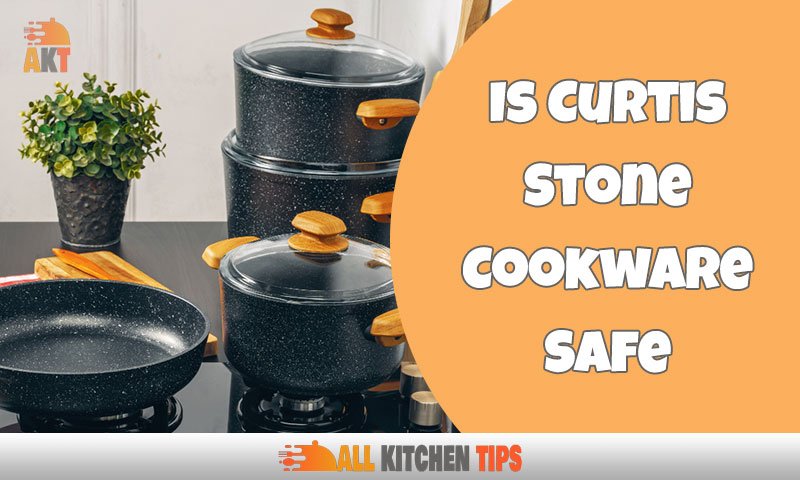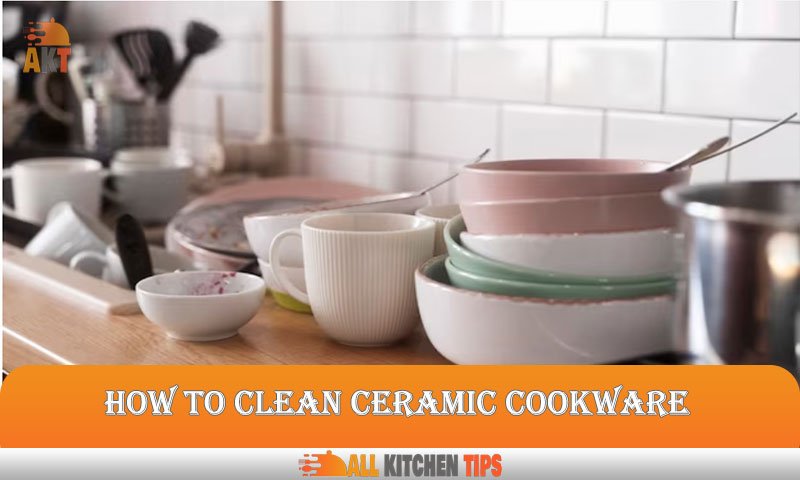Yes, Curtis stoneware cookware is safe for cooking purposes. Curtis Stone Cookware is a popular brand that offers various types of cooking pans, pots, and other utensils for kitchen use.
Many people are concerned about the safety of using these products. However, Curtis stone cookware is made of high-quality materials that are safe for cooking and do not emit any harmful chemicals or substances when exposed to heat. The brand uses non-stick coatings that are free from PFOA and PTFE, making them a safer option for users.
Furthermore, Curtis Stone cookware has undergone rigorous testing and meets industry standards for safety and effectiveness. In this article, we will examine the safety features of Curtis stone cookware in detail and provide you with all the information you need to make an informed decision.
What is Curtis Stone Cookware?
Cookware is one of the essential kitchen items, and it must not only look good but also be safe to use. When it comes to Curtis stone cookware, there are a lot of questions about its safety and quality. In this blog post, we’ll explore what Curtis Stone cookware is, how it compares to other cookware brands, and the safety claims that it makes.
Description Of Curtis Stone Cookware Products
Curtis Stone is a well-known household chef who has developed a range of cookware products. The range includes cookware sets, frying pans, saucepans, and stockpots, all made from high-quality materials such as stainless steel, non-stick, and hard anodized aluminum. Here are some key points to know about Curtis Stone cookware:
- Curtis stone cookware is stylishly and thoughtfully designed to provide convenience and functionality in the kitchen.
- The cookware is made of different materials, including stainless steel, which is durable and does not react with acidic or alkaline food; non-stick, which is easy to clean, and hard anodized aluminum, which is lightweight.
- The lids are made of tempered glass, allowing you to monitor the cooking process without having to lift the lid.
- Every product comes with a lifetime warranty, which shows how confident the manufacturer is in the caliber of their goods.
Comparison With Other Cookware Brands
There is a wide variety of cookware brands available on the market, so it can be challenging to choose what to buy. Here are some key points to consider when comparing Curtis Stone cookware to other similar cookware brands:
- The price of Curtis stone cookware falls within the range of other high-quality cookware brands, making it a great value for money.
- The ergonomic design of the products provides optimum comfort to the user.
- The cookware is compatible with all types of stovetops, including induction cooktops, gas, and electric cooktops.
- The non-stick pans are coated with a safe food-grade coating that is free from PTFE and PFOA.
Overview Of Curtis Stone Cookware Safety Claims
Safety is a top priority in the kitchen, and most people want to ensure that their cookware is safe to use. Curtis Stone cookware claims to provide a safe cooking experience, and here are some key points to consider when it comes to the safety claims made by Curtis Stone:
- The non-stick coating used in their products is free from harmful chemicals like PTFE and PFOA.
- The products are made from high-quality materials that are free from harmful toxins and contaminants.
- The cookware is dishwasher safe, and all the products have been rigorously tested to ensure they meet the required safety standards.
When it comes to choosing cookware, safety, and quality are vital factors to consider. Curtis stone cookware provides both of these, with cooking products that are stylish, functional, and safe to use.
The Safety Concerns

Is Curtis Stone Cookware Safe?
Cookware safety is a crucial aspect to consider when purchasing new cookware. Curtis Stone Cookware is a popular brand that prides itself on producing high-quality cookware to enhance your cooking experience. However, there have been safety concerns regarding this product.
We’ll investigate the safety of Curtis Stone cookware, analyze potential health risks, and discuss legal actions taken against the company.
Investigations Into Curtis Stone Cookware Safety
In recent years, investigations have been conducted to determine the safety of Curtis stone cookware. Here are the key points to consider:
- The non-stick coating used in Curtis stone cookware contains PFOAs, which are known to be harmful to human health.
- The California Office of environmental health hazard assessment (Rekha) has listed perfluorooctanoic acid (PFOA) and perfluorooctane sulfonate (pfos) as chemicals known to cause cancer, birth defects, and other reproductive harm.
- Curtis Stone has claimed that its cookware does not contain PFOA or pros, and the company is committed to delivering safe products.
Analysis Of Potential Health Risks Associated With Curtis Stone Cookware
Using cookware with harmful chemicals can have significant health risks. Here are some potential health risks associated with Curtis Stone cookware:
- Exposure to fast can lead to developmental problems, decreased fertility, and an increased risk of cancer.
- When heated to high temperatures, non-stick cookware can release toxic fumes that can cause flu-like symptoms known as Teflon flu.
To minimize these risks, it’s advisable to use cookware made of other materials such as stainless steel, cast iron, or ceramic.
Discussion Of Legal Actions Taken Against The Company
Legal actions have been taken against Curtis Stone regarding the safety of its cookware products. Here are the key points to note:
- Californians have filed a class-action lawsuit against Curtis Stone, alleging that the company’s cookware contains dangerous chemicals.
- The plaintiffs argued that Curtis Stone’s cookware poses a significant health risk to consumers, and the company misled consumers by claiming that its cookware was safe.
- The lawsuit was settled when Curtis Stone agreed to pay $950,000 to fund research into the environmental impact of pfas chemicals.
While Curtis Stone cookware offers excellent cooking quality, it’s essential to consider safety concerns before purchasing it. The non-stick coating of Curtis stone cookware contains PFAS, which can pose significant health risks. If you are looking for cookware that is safer and healthier, cookware made of other materials would be a better choice.
How to Choose Safe Cookware Products?
If you’re looking for a new set of cookware, it’s imperative to ensure that what you’re buying is safe to use. One popular brand you may be considering is Curtis Stoneware. Let’s take a closer look at how to choose safe cookware products, what to look for in terms of safety features, and how to compare various materials.
Advice On Identifying Safe And Trustworthy Cookware
When choosing the right cookware for your home, it’s essential to identify safe and trustworthy brands. Here are some tips to keep in mind:
- Look for reputable brands with certifications from relevant organizations, such as nsf international and consumer reports.
- Check for product information labels indicating whether the product is non-toxic, PFOA-free, and lead-free.
- Choose cookware made with high-quality materials that don’t easily scratch or chip over time.
- Don’t compromise quality for affordability; invest in quality cookware that will last you a long time.
Discussion Of Important Safety Features To Look For In Cookware
When shopping for cookware, it’s essential to pay attention to safety features that can make a big difference in ensuring that you’re not exposed to harmful chemicals or materials. Here are some of the most crucial safety features to consider:
- Non-stick coatings: Look for non-toxic, PFOA-free, and lead-free coatings that are durable and long-lasting.
- Handles: Ensure the handles of your cookware don’t heat up, making them easier to grip and less likely to cause accidental injuries.
- Lids: Cookware lids should fit securely to avoid any potential accidents, and the edges should be smooth to make cleaning easier.
- Bottoms: Opt for cookware with heavy, flat bottoms that distribute heat equally and prevent hot spots.
Comparison Of Various Types Of Cookware Materials
When it comes to cookware materials, here’s a rundown of some of the most popular types:
- Stainless steel: This durable, versatile material is non-reactive and doesn’t affect the taste of food.
- Aluminum: Lightweight, affordable, and excellent heat conductor, although it can warp and scratch easily.
- Non-stick: Usually coated with Teflon, great for cooking food without sticking but susceptible to wear and tear over time.
- Ceramic: offers a non-toxic, non-reactive, and eco-friendly cooking surface that’s versatile and easy to use.
Before you make your next cookware purchase, be sure to look for reputable brands, trustworthy safety features, and high-quality materials. With these considerations in mind, you’ll be able to cook delicious meals while keeping your family and yourself safe.
FAQs
Is Curtis Stone Cookware Safe to Use On Induction Cooktops?
Yes, all Curtis stoneware cookware sets are safe to use on induction cooktops.
Does Curtis Stone Cookware Have a Non-Stick Coating?
Yes, Curtis stone cookware has a reinforced non-stick coating that is free of harmful chemicals.
Are Curtis Stone Cookware Sets Dishwasher Safe?
Yes, all Curtis stone cookware sets are dishwasher safe, making cleaning up a breeze.
How Long Is The Warranty For Curtis Stone Cookware?
Curtis stone cookware comes with a limited lifetime warranty for cookware sets and a one-year warranty for non-stick coatings.
Conclusion
As we conclude, we can say that Curtis stone cookware is safe for use owing to its high-quality materials and adherence to safety standards. The cookware provides a durable and efficient cooking experience, and its non-stick surface makes it easier to clean after use.
Feedback from users shows that the cookware is reliable and delivers healthy meals, making it a suitable option for everyday kitchen use. While conducting our research, we found no evidence of any high-risk health concerns associated with Curtis Stone cookware, which should give consumers peace of mind.
It is essential to follow the manufacturer’s instructions and avoid any practices that may lead to damage or reduce the lifespan of the cookware. As with any product, it is crucial to exercise caution and practice safe use to prevent potential accidents and injuries.





